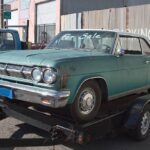Renting a car opens up a world of exploration, giving you the freedom to discover new destinations at your own pace. Most car rentals are smooth sailing, but sometimes, things can take an unexpected turn. When issues arise, explaining what’s happening requires clear communication, and if you’re in an English-speaking country or dealing with English-speaking services, knowing the right vocabulary for Parts Of The Car English is crucial.
Whether you’re navigating the roads of the United States, cruising through England, or in any of the numerous countries where English is the language of business, understanding car part names in English is incredibly useful.
This guide will equip you with the essential English vocabulary to talk about your car, from the engine to the exhaust and everything in between. So, buckle up as we dive into the world of automotive English!
The Car’s Front Section: Vital Components
1. Hood (Bonnet in British English)
Let’s begin at the front with the hood (also known as the bonnet in the UK). This is the metal cover at the front of the car that protects the engine. Typically, there’s a lever inside the car, usually on the driver’s side, to release and lift the hood. It’s a smart idea to locate this lever beforehand so you’re not struggling to pop the hood in a stressful situation.
2. Bumper
Cars are equipped with bumpers at both the front and rear. These reinforced bars, made of plastic, metal, or a combination, are designed to absorb impact and minimize damage to the car’s body in minor collisions, like parking bumps.
3. Headlights & Light Systems
Headlights are the powerful lights at the front of your vehicle, essential for driving at night or in low visibility conditions. It’s important to be aware of local regulations regarding daytime running lights. Distinguish between high beams (bright lights for open roads) and low beams (standard lights for city driving and traffic) to ensure safe and courteous driving. Besides headlights, remember terms like turn signals (indicators) and fog lights for comprehensive car light vocabulary.
4. Windshield (Windscreen in British English) and Wipers
The large glass panel at the front is the windshield (or windscreen in British English). Its primary function is to shield you from wind, insects, and road debris while driving. Windshield wipers are crucial for clearing rain, snow, or debris from the windshield to maintain visibility. Don’t forget windshield washer fluid to clean tougher grime.
5. Side Mirrors (Wing Mirrors in British English)
Side mirrors, also known as wing mirrors in the UK, are mounted on the sides of the car, providing rear visibility. One is on the driver’s side, and the other on the passenger side. Adjusting these correctly is vital for safe lane changes and parking.
6. Tires (Tyres in British English)
At each corner of the car are tires (or tyres in British English). Standard cars have four tires – rubber rings filled with air that provide grip and cushioning. Insufficient air pressure can lead to a flat tire. Most cars carry a spare tire, usually located in the trunk or under the vehicle, for emergency replacements. Knowing how to change a tire is a valuable skill for any driver.
Rear Car Components: Back-End Basics
1. Trunk (Boot in British English)
The trunk (or boot in British English) is the rear storage compartment of the car, analogous to the hood at the front. This is where luggage, groceries, and often the spare tire and emergency kit are stored. Emergency kits typically include a first-aid kit and a high-visibility vest.
2. Tail Lights and Brake Lights
Tail lights are the red lights at the rear of the vehicle, always illuminated when the headlights are on, making the car visible from behind. Brake lights, a subset of tail lights, are brighter red lights that illuminate when you are braking (slowing down), warning drivers behind you.
3. Fuel Tank and Fuel Cap
The fuel tank is where gasoline or diesel is stored. A small door, often called the fuel cap cover, conceals the fuel cap. Opening this cover usually requires a press or pull. Always double-check the correct fuel type for your rental car before filling up to avoid engine damage.
Just like the front, the rear of the car also features a bumper for protection.
Power and Performance: Key Mechanical Parts
1. Engine: The Heart of the Car
The engine is the powerhouse of the car, located under the hood. It’s a complex machine that converts fuel into motion, making the car run. Understanding basic engine issues can be helpful in communicating with mechanics.
2. Battery: Electrical Power Source
The car battery provides the electrical energy to start the engine and power the car’s electrical systems. A depleted battery is called a flat battery or dead battery. This is a common issue, especially in cold weather or with older batteries. Jump starting a car with a flat battery is a useful emergency procedure.
3. Brakes: Safety First
Brakes are crucial for slowing down and stopping the car, ensuring road safety. “Hit the brakes” is a common phrase meaning to apply the brakes immediately. Different types of brakes include disc brakes and drum brakes.
4. Gas Pedal/Accelerator Pedal: Speed Control
The gas pedal or accelerator pedal controls the car’s speed. “Step on it” or “hit the gas” are informal ways to say accelerate or drive faster. Understanding the sensitivity of the gas pedal is important for smooth driving.
Interior Car Parts: Inside the Cabin
1. Steering Wheel: Direction Control
The steering wheel controls the direction of the car. Turning the wheel left or right steers the car accordingly. Power steering makes turning the wheel easier.
2. Dashboard: Information Hub
The dashboard is the control panel in front of the driver. It displays vital information such as speed (speedometer), fuel level (fuel gauge), engine temperature, and various warning lights. It also often houses the car’s infotainment system and air conditioning controls.
3. Gear Stick/Stick Shift (for Manual Cars)
In manual cars, the gear stick or stick shift is used to change gears. This allows the driver to control the engine’s power and speed. Automatic cars have a simpler gear selector, often with positions like “Park,” “Drive,” “Neutral,” and “Reverse.”
4. Airbags: Safety Cushion
Airbags are safety devices that inflate rapidly in a collision, providing a cushion to protect occupants from hitting hard surfaces inside the car. They are a critical safety feature in modern vehicles.
5. Parking Brake (Handbrake in British English)
The parking brake, also called a handbrake in British English, is a lever or pedal used to keep the car stationary when parked, especially on an incline. It prevents the car from rolling. You must release or take off the parking brake before you set off (start driving).
Ready to Drive Confidently?
With this enhanced vocabulary of parts of the car english, you’re now better prepared to handle car rentals and road trips with confidence. You can now communicate effectively with mechanics about issues like a flat tire or battery, or request services like windshield cleaning while refueling. So, get ready to start your engine and enjoy the journey, knowing you speak the language of cars!
Choose your plan


